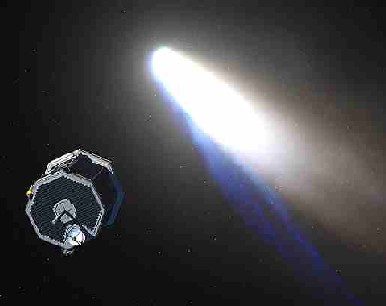This illustration shows an artist concept of the NASA Comet Nucleus Tour (CONTOUR) spacecraft.
Click on image for full size
Courtesy of NASA
CONTOUR Lost in Space
News story originally written on August 27, 2002
We are sad to report that the Comet Nucleus Tour (CONTOUR) is currently lost in space. The CONTOUR spacecraft was launched July 3, 2002 to explore the nucleus of comets. It was scheduled to fly by at least two comets over the next few years, taking pictures and collecting dust from the nucleus of each.
Controllers lost contact with CONTOUR on Aug. 15, when its rocket ignited 140 miles above the Earth to boost the spacecraft out of Earth's orbit. Controllers expected to regain contact within an hour, but there has been no contact with CONTOUR since the rockets ignited.
By searching the skies with the telescope in Kitt Peak, Arizona, scientists found three objects in the location where CONTOUR should be. Since CONTOUR was originally in one piece, these pictures may indicate that it has broken apart.
Mission controllers may have lost CONTOUR but they have not lost hope! There is a possibility that the main part of the spacecraft is still intact if only non-essential parts fell off. They will continue listening for signals from the spacecraft until early December, when CONTOUR will be in a better location to receive a signal from Earth.
Last modified August 27, 2002 by Lisa Gardiner.
You might also be interested in:

It was another exciting and frustrating year for the space science program. It seemed that every step forward led to one backwards. Either way, NASA led the way to a great century of discovery. Unfortunately,
...more
The Space Shuttle Discovery lifted off from Kennedy Space Center on October 29th at 2:19 p.m. EST. The weather was great as Discovery took 8 1/2 minutes to reach orbit. This was the United States' 123rd
...more
A moon was discovered orbiting the asteroid, Eugenia. This is only the second time in history that a satellite has been seen circling an asteroid. A special mirror allowed scientists to find the moon
...more
Will Russia ever put the service module for the International Space Station in space? NASA officials want an answer from the Russian government. The necessary service module is currently waiting to be
...more
A coronal mass ejection (CME) happened on the Sun early last month. The material that was thrown out from this explosion passed the ACE spacecraft. The SWICS instrument on ACE has produced a new and very
...more
J.S. Maini of the Canadian Forest Service called forests the "heart and lungs of the world." This is because forests filter air and water pollution, absorb carbon dioxide, release oxygen, and maintain
...more
In late April through mid-May 2002, all five naked-eye planets are visible at the same time in the night sky! This is includes Mercury which is generally very hard to see. You won't want to miss this!
...more















